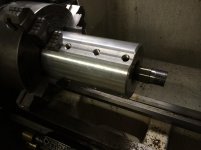dogurek
Plastic
- Joined
- Feb 19, 2013
- Location
- St Louis, MO
Hello,
I'm trying to thread a barrel tenon using a barrel holding fixture similar to this one:
https://shop.pacifictoolandgauge.com/index.php?main_page=product_info&cPath=5_28&products_id=1457&zenid=tnruh5dqr8p79p6kdhrn4nr2q3
Best I can tell, it's not holding the barrel tight, which I don't understand. I put the barrel in and indicated on a range rod to within 0.0001" and then cut the tenon and thread relief with no problem. I re-indicated it, and started threading. About 3/4 of the way to my final thread depth, the bit caught and jammed up the thread. It wasn't too bad and since I wasn't at my final thread depth yet, I re-indicated it, set up the bit to chase the threads and began to slowly pickup the threads to clean it up and cut it to final depth. It was during this that I realized that every time I made a pass, and I was taking 0.001" on the compound at 29.5*, that the barrel was getting knocked out of alignment with each pass. So, I started doing a cut, re-aligning, doing a cut, re-aligning, etc, etc. I found that the barrel was getting knocked out of alignment about between 0.003 to 0.010" with each 0.001" pass!!! Finally, one pass must have knocked it way out and it crashed the threads again and I don't believe they are repairable anymore.
It wasn't too bad and since I wasn't at my final thread depth yet, I re-indicated it, set up the bit to chase the threads and began to slowly pickup the threads to clean it up and cut it to final depth. It was during this that I realized that every time I made a pass, and I was taking 0.001" on the compound at 29.5*, that the barrel was getting knocked out of alignment with each pass. So, I started doing a cut, re-aligning, doing a cut, re-aligning, etc, etc. I found that the barrel was getting knocked out of alignment about between 0.003 to 0.010" with each 0.001" pass!!! Finally, one pass must have knocked it way out and it crashed the threads again and I don't believe they are repairable anymore.
I tightened the set screws for each alignment and believe me, that bugger was in there tight! I'm using a HSS threading bit from Arthur Warner and it's sharp. So, I'm a barrel down and I certainly don't want to put another one in there until I know why it's getting messed up. I just can't imagine how it's getting knocked around that much with such light passes.
Anyone have any experience with a similar fixture or suggestions?
Thanks,
Dave

I'm trying to thread a barrel tenon using a barrel holding fixture similar to this one:
https://shop.pacifictoolandgauge.com/index.php?main_page=product_info&cPath=5_28&products_id=1457&zenid=tnruh5dqr8p79p6kdhrn4nr2q3
Best I can tell, it's not holding the barrel tight, which I don't understand. I put the barrel in and indicated on a range rod to within 0.0001" and then cut the tenon and thread relief with no problem. I re-indicated it, and started threading. About 3/4 of the way to my final thread depth, the bit caught and jammed up the thread.
 It wasn't too bad and since I wasn't at my final thread depth yet, I re-indicated it, set up the bit to chase the threads and began to slowly pickup the threads to clean it up and cut it to final depth. It was during this that I realized that every time I made a pass, and I was taking 0.001" on the compound at 29.5*, that the barrel was getting knocked out of alignment with each pass. So, I started doing a cut, re-aligning, doing a cut, re-aligning, etc, etc. I found that the barrel was getting knocked out of alignment about between 0.003 to 0.010" with each 0.001" pass!!! Finally, one pass must have knocked it way out and it crashed the threads again and I don't believe they are repairable anymore.
It wasn't too bad and since I wasn't at my final thread depth yet, I re-indicated it, set up the bit to chase the threads and began to slowly pickup the threads to clean it up and cut it to final depth. It was during this that I realized that every time I made a pass, and I was taking 0.001" on the compound at 29.5*, that the barrel was getting knocked out of alignment with each pass. So, I started doing a cut, re-aligning, doing a cut, re-aligning, etc, etc. I found that the barrel was getting knocked out of alignment about between 0.003 to 0.010" with each 0.001" pass!!! Finally, one pass must have knocked it way out and it crashed the threads again and I don't believe they are repairable anymore.I tightened the set screws for each alignment and believe me, that bugger was in there tight! I'm using a HSS threading bit from Arthur Warner and it's sharp. So, I'm a barrel down and I certainly don't want to put another one in there until I know why it's getting messed up. I just can't imagine how it's getting knocked around that much with such light passes.
Anyone have any experience with a similar fixture or suggestions?
Thanks,
Dave



